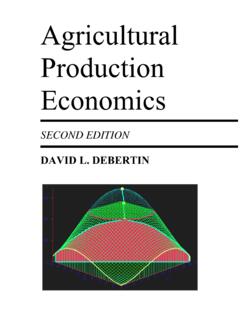Transcription of Intermediate Microeconomics - Yonsei
1 Intermediate Microeconomicsby Jinwoo Kim1 Contents1 The Market42 Budget Constraint83 Preferences104 Utility145 Choice186 Demand247 Revealed Preference278 Slutsky Equation309 Buying and Selling3310 Intertemporal Choice3712 Uncertainty3914 Consumer Surplus4315 Market Demand4618 Technology4819 Profit Maximization5220 Cost Minimization5421 Cost Curves5722 Firm Supply5923 Industry Supply6224 Monopoly64225 Monopoly Behavior6726 Factor Market7227 Oligopoly7628 Game Theory8030 Exchange853Ch. 1. The MarketI. Economic model:A simplified representation of realityA.
2 An example Rental apartment market in Shinchon: Object of our analysis Price of apt. in Shinchon: Endogenous variable Price of apt. in other areas: Exogenous variable Simplification: All (nearby) Apts are identicalB. We ask How the quantity and price are determined in a given allocation mechanism How to compare the allocations resulting from different allocation mechanismsII. Two principles of economics Optimization principle: Each economic agent maximizes its objective ( utility, profit,etc.) Equilibrium principle: Economic agents actions must be consistent with each otherIII.
3 Competitive marketA. Demand Tow consumers with a single-unit demand whose WTP s are equal tor1andr2(r1< r2)r2r1pQ12 Many people4 QpQp4 consumers consumersB. Supply Many competitive suppliers Fixed at Qin the short-runC. Equilibrium Demand must equal supply QQ pQpp p Eq. price (p ) and eq. quantity ( Q)D. Comparative statics: Concerns how endogenous variables change as exogenous variableschange {Comparative: Compare two eq aStatistics: Only look at eq a, but not the adjustment process For instance, if there is exogenous increase in supply, Q Q , thenp p 5 III.}
4 Other allocation mechanismsA. MonopolypQ Qp p B. Rent control: Price ceiling at p < p Excess demand Rationing (or lottery)IV. Pareto efficiency:Criterion to compare different economic allocationsA. One allocation is aPareto improvementover the other if the former makes some peoplebetter off without making anyone else worse off, compared to the An allocation is calledPareto efficient(PE) if there is no Pareto , the allocation is calledPareto inefficientC. Example: Rent control is not PE Suppose that there are 2 consumers, A and B, who value an apt atrAandrB> rA.
5 As a result of pricing ceiling and rationing, A gets an apt and B does not6 This is not Pareto efficient since there is Pareto improvement: Let A sell his/her apt. toB at the price ofp (rA,rB)BeforeAfterLandlord p pArA pp p(> rA p)B0rB p(>0) A and B are better off while no one is worse offD. An allocation in the competitive market equilibrium is PE7Ch. 2. Budget Constraint Consumer s problem: Choose the best bundle of goods that one can afford Consider a consumer in an economy where there are 2 goods (x1,x2): A bundle of two goods: Endogenous variable (p1,p2): Prices;m: Consumer s income: Exogenous variableI.
6 Budget set:Set of allaffordablebundles p1x1+p2x2 mx2x1m/p2m/p1p1/p2m/p2m/p1=p1p2= the market exchange rate b/w the two goodsor opportunity cost of good 1 in terms of good 2II. Changes in budget set See how budget set changes as exogenous variables changeA. Increase in income:m < m 8B. Increase in the price of one good:p1< p 1C. Proportional increase in all prices and income:(p1,p2,m) (tp1,tp2,tm) Numeraire: Lett=1p1 x1+p2p1x2=mp1that is,the price of good 1 is 1 III. Application:Tax and subsidyA. Quantity tax: Tax levied on each unit of, say, good 1 bought Given tax ratet,p 1=p1+tB.
7 Value tax: Tax levied on each dollar spent on good 1 Given tax rate ,p 1=p1+ p1= (1 + )p1C. Subsidy: Negative Quantity subsidy for the consumption of good 1 exceeding x19Ch. 3. PreferencesI. Preference:Relationship (or rankings) between consumption bundlesA. Three modes of preference: Given two Bundles,x= (x1,x2)andy= (y1,y2) y:x is (strictly) preferred to y:x is indifferent to y:x is weakly preferred to yExample.(x1,x2) (y1,y2)ifx1+x2 y1+y2B. The relationships between three modes of y x yorx y x yandy y x ybut noty xC.
8 Properties of preference yory x2. Reflexive: Given anyx,x x3. Transitive: Givenx,y, andz, ifx yandy z, thenx the preference in the above example satisfy all 3 properties? If is transitive, then and are also transitive: For instance, ifx yandy z,thenx zD. Indifference curves: Set of bundles which are indifferent to one another10024681012024681012 ABx1x2 Two different indifferent curves cannot intersect with each other Upper contour set: Set of bundles weakly preferred to a given bundlexII. Well-behaved preferenceA. Monotonicity: More is better Preference is monotonic ifx yfor anyxandysatisfyingx1 y1,x2 y2 Preference isstrictlymonotonic ifx yfor anyxandysatisfyingx1 y1,x2 y2, andx6= is violated by the satiated preference:B.
9 Convexity: Moderates are better than extremes Preference is convex if for anyxandywithy x, we havetx+ (1 t)y xfor allt [0,1]11x2x1 Convex Preferencex2x1 Non-convex Preferencetx+ (1 t)yxytx+ (1 t)yxy Convex preference is equivalent to the convex upper contour set Preference isstrictlyconvex if for anyxandywithy x, we havetx+ (1 t)y xfor allt (0,1)III. ExamplesA. Perfect substitutes: Consumer likes two goods equally so only the total number of goodsmatters 2 goods are perfectly and Red pencilB. Perfect complement: One good is useless without the other It is not possible to sub-stitute one good for the and Left shoe12C.
10 Bads: Less of a bad is and Food This preference violates the monotonicity but there is an easy fix: Let Leisure=24hours Labor and consider two goods, Leisure and Marginal rate of substitution (MRS):MRS at a given bundlexis the marginalexchange rate between two goods to make the consumer indifferent tox. (x1,x2) (x1 x1,x2+ x2) MRS atx= lim x1 0 x2 x1=slope of indifference curve atx MRS decreases as the amount of good 1 increases13Ch. 4. UtilityI. Utility function: An assignment of real numberu(x) Rto each bundlexA.









